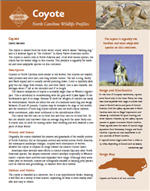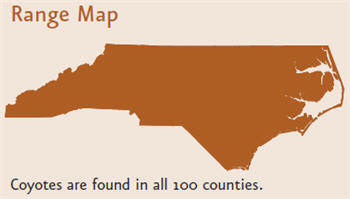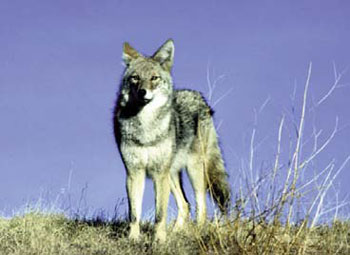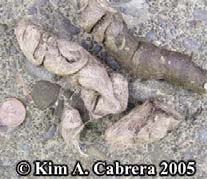
Classification
Class: Mammalia
Order: Carnivora
Average Size
Length: 3-4 ft.
Height: 2 ft. at shoulder
Weight: 20-45 lbs., with females a few pounds less.
Food

The coyote is opportunistic, eating a variety of foods depending on what is most readily available. Primary foods include fruits and berries, rodents, rabbits, deer, birds, snakes, frogs, and insects. They also scavenge on animal remains, roadkill, garbage, and outdoor pet food.
Breeding
Coyotes generally mate for life. Mating occurs January to March. Gestation period is 60 to 63 days.
Young
Called pups. Coyote litters average 4-6 pups, but can be as many as 12 pups. They are fed by both parents and sometimes by related helpers. They emerge from the den at 3 weeks, are weaned at 5 to 7 weeks, and learn to hunt at 8 or 9 weeks. The family unit usually begins to disperse by November or December. In many cases, one pup (usually a female) stays behind to help with the next year’s litter.
Range and Distribution

At the time of European settlement, coyotes were found only in the Great Plains, but they have since expanded their range to most of North America and parts of Central America. Prior to the 1980s, coyotes in North Carolina were illegally imported for hunting. However, by the 1980s, coyotes started to move into western North Carolina from Tennessee, Georgia and South Carolina. Coyotes are now established statewide in North Carolina.
A coyote’s home range varies from 2 to 25 miles, depending on season, habitat and food availability. A coyote’s territory is usually 2 to 3 square miles. Coyotes actively defend their territory through howling, scent marking with urine, body displays, and confrontation.
Coyotes have high dispersal rates and can travel over 100 miles. When a coyote or family group leaves or is removed, new coyotes usually move into the vacant territory. This makes population estimation and control difficult.
The coyote is named from the Aztec word, coyotl, which means “barking dog,” and is a familiar figure as “the trickster” in many Native American stories. The coyote is native only in North America and has the widest range of all wild canines in this country. It is one of the most adaptable mammal on this continent.
Description

Coyotes in North Carolina resemble red wolves, but coyotes are smaller, have pointed and erect ears, and long slender snouts. Their long, bushy, black-tipped tail is usually carried pointing down. Color is typically dark gray but can range from blonde, red, to black. Coyotes may be mistaken for dogs or red wolves, and the existence of hybrids, though uncommon, makes identification more confusing.
The coyote has five toes on its front feet (including the dew claw that does not appear in tracks) and four toes on its hind feet. Its feet are smaller and narrower than an average dog with the same body size.
History and Status
Originally, the coyote inhabited the prairies and grasslands of the middle portion of North America. But as Europeans arrived and settled across North America, the subsequent landscape changes, coupled with elimination of wolves, allowed the coyote to expand its range toward the eastern Un ited States.
Americans have devoted more efforts to control coyotes than any other North American species. But despite extensive control attempts (especially in Western states), coyotes have survived and expanded their range. Although they sometimes prey on livestock, coyotes are ecologically valuable in keeping prey species, such as rodents and groundhogs, in balance with their habitat.
Habitat and Habits
Originally, coyotes inhabited the prairies and grasslands of the Great Plains. But as Europeans settled across North America, the subsequent landscape changes and elimination of wolves allowed coyotes to expand their range eastward. Despite extensive control attempts, coyotes have survived and expanded their range. When populations are reduced, the remaining coyotes respond by breeding at a younger age and producing larger litter sizes with high pup survivorship, making their populations resilient.
Coyotes survive anywhere with food sources. Their habitat can range from agricultural fields to forests, to suburban and urban environments. They are adaptable in behavior and diet. Coyotes are ecologically valuable in keeping prey species, such as rodents and groundhogs, in check.
Coyotes birth their young in dens. Although coyotes usually dig their own den, they sometimes modify another animal’s den or a natural hole, such as under a rocky ledge, to suit their own needs.
People Interactions
Coyotes have played a role in the lives of Americans as far back as this country’s history is recorded. Native American stories often depict coyotes as clever and tricky.
Coyotes get negative attention today because they sometimes prey on livestock and domestic pets. Coyotes are naturally wary of people and will avoid areas in which threats are perceived. However, they may become acclimated to humans in the absence of threats (such as hunting and trapping) and where food sources such as pet food, garbage and unsupervised small pets are available.
Although some people find a coyote’s howl unnerving, this howl serves many purposes. Coyotes howl to locate pack members, distrac

t threats away from their den, or establish their territory. In the late summer, pups practice howling to mimic their parents. Because of the hollow tone of the howl, a pair of coyotes often sounds like a huge group and may seem closer than they actually are.
NCWRC Interaction
The North Carolina Wildlife Resources Commission and N.C. State University have conducted studies on the food habits of coyotes in North Carolina. A study on Fort Bragg found that soft mast (persimmons and berries) was the primary food item in coyote scat (41%), followed by mammals (29%) and insects (21%). Another study on the Albemarle Peninsula found that small rodents were the primary food item in coyote scat (33%), followed by rabbits (30%) deer, (25%), other mammals (8%) and vegetation (3%). Future research is planned to further understand this adaptable animal.
